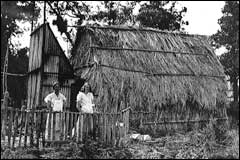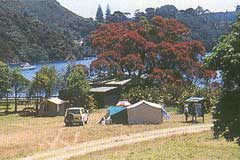European Settlement
 In 1933 settlers on the island lived and ate in nikau shanties such as this one at Peachtree Camp |
|
 The steep hillsides of the western coast of Great Barrier Island at Port Abercrombie |
Europeans settled Great Barrier Island in the early 1800's. The settlers started to extract and use the natural resources they found. The activities included mining, whaling, milling, kauri gum digging and farming.
Today DoC administers the land that was once used for these industries. There are many reminders of this once huge industrial phase of Great Barrier. The kauri dams at Kaiarara, the early copper mine at Miners Head and the whaling station at Whangaparapara are all historic sites. DoC's programme of work includes preserving these historical features on the island.
Today many people choose to live on Great Barrier Island for it's natural beauty and the life style it offers. There are around 1200 permanent residents on the island. Many farming families are descendants of original settlers. Most residents of Great Barrier Island live in the south around Tryphena, Medlands, Okupu, Whangaparapara and Claris.
For visitors the island offers a wide range of opportunities for walking, tramping, scientific study and outdoor education.
The Department of Conservation field centre is at Akapoua (Port Fitzroy) with a field base at Claris (Kaitoke) and Okiwi (Whangapoua). Staff can also stay at Tryphena and Whangaparapara.